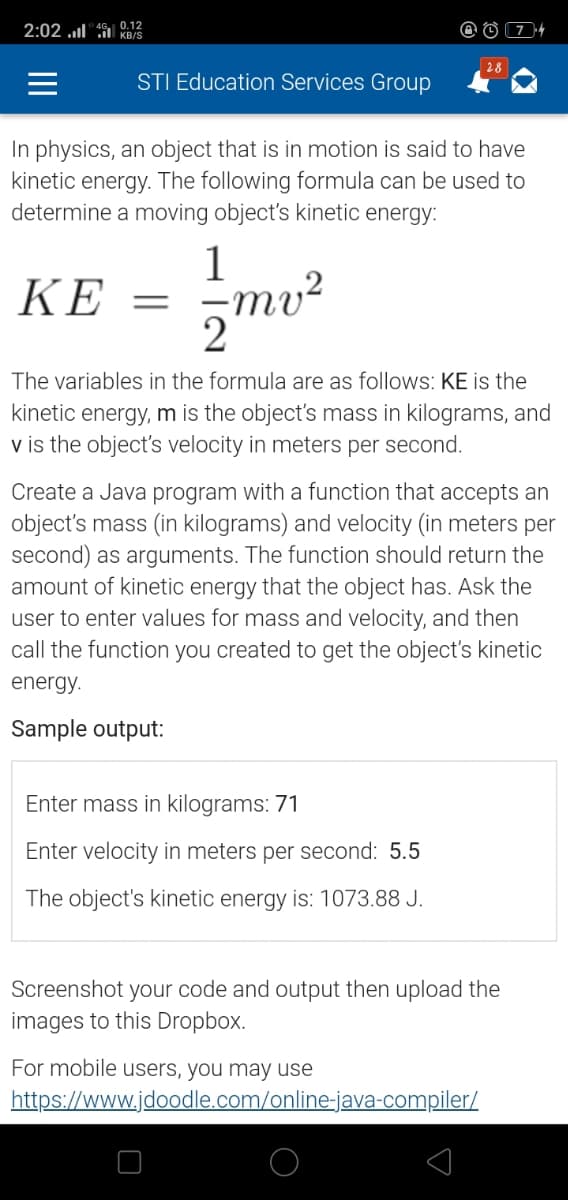Create a Java program with a function that accepts an object's mass (in kilograms) and velocity (in meters per second) as arguments. The function should return the amount of kinetic energy that the object has. Ask the user to enter values for mass and velocity, and then call the function you created to get the object's kinetic energy.
Create a Java program with a function that accepts an object's mass (in kilograms) and velocity (in meters per second) as arguments. The function should return the amount of kinetic energy that the object has. Ask the user to enter values for mass and velocity, and then call the function you created to get the object's kinetic energy.
Computer Networking: A Top-Down Approach (7th Edition)
7th Edition
ISBN:9780133594140
Author:James Kurose, Keith Ross
Publisher:James Kurose, Keith Ross
Chapter1: Computer Networks And The Internet
Section: Chapter Questions
Problem R1RQ: What is the difference between a host and an end system? List several different types of end...
Related questions
Question
100%

Transcribed Image Text:2:02 „l" 0.12
KB/S
| 28
STI Education Services Group
In physics, an object that is in motion is said to have
kinetic energy. The following formula can be used to
determine a moving object's kinetic energy:
1
ΚΕ
The variables in the formula are as follows: KE is the
kinetic energy, m is the object's mass in kilograms, and
v is the object's velocity in meters per second.
Create a Java program with a function that accepts an
object's mass (in kilograms) and velocity (in meters per
second) as arguments. The function should return the
amount of kinetic energy that the object has. Ask the
user to enter values for mass and velocity, and then
call the function you created to get the object's kinetic
energy.
Sample output:
Enter mass in kilograms: 71
Enter velocity in meters per second: 5.5
The object's kinetic energy is: 1073.88 J.
Screenshot your code and output then upload the
images to this Dropbox.
For mobile users, you may use
https://www.jdoodle.com/online-java-compiler/
Expert Solution
This question has been solved!
Explore an expertly crafted, step-by-step solution for a thorough understanding of key concepts.
This is a popular solution!
Trending now
This is a popular solution!
Step by step
Solved in 3 steps with 1 images

Recommended textbooks for you

Computer Networking: A Top-Down Approach (7th Edi…
Computer Engineering
ISBN:
9780133594140
Author:
James Kurose, Keith Ross
Publisher:
PEARSON

Computer Organization and Design MIPS Edition, Fi…
Computer Engineering
ISBN:
9780124077263
Author:
David A. Patterson, John L. Hennessy
Publisher:
Elsevier Science

Network+ Guide to Networks (MindTap Course List)
Computer Engineering
ISBN:
9781337569330
Author:
Jill West, Tamara Dean, Jean Andrews
Publisher:
Cengage Learning

Computer Networking: A Top-Down Approach (7th Edi…
Computer Engineering
ISBN:
9780133594140
Author:
James Kurose, Keith Ross
Publisher:
PEARSON

Computer Organization and Design MIPS Edition, Fi…
Computer Engineering
ISBN:
9780124077263
Author:
David A. Patterson, John L. Hennessy
Publisher:
Elsevier Science

Network+ Guide to Networks (MindTap Course List)
Computer Engineering
ISBN:
9781337569330
Author:
Jill West, Tamara Dean, Jean Andrews
Publisher:
Cengage Learning

Concepts of Database Management
Computer Engineering
ISBN:
9781337093422
Author:
Joy L. Starks, Philip J. Pratt, Mary Z. Last
Publisher:
Cengage Learning

Prelude to Programming
Computer Engineering
ISBN:
9780133750423
Author:
VENIT, Stewart
Publisher:
Pearson Education

Sc Business Data Communications and Networking, T…
Computer Engineering
ISBN:
9781119368830
Author:
FITZGERALD
Publisher:
WILEY